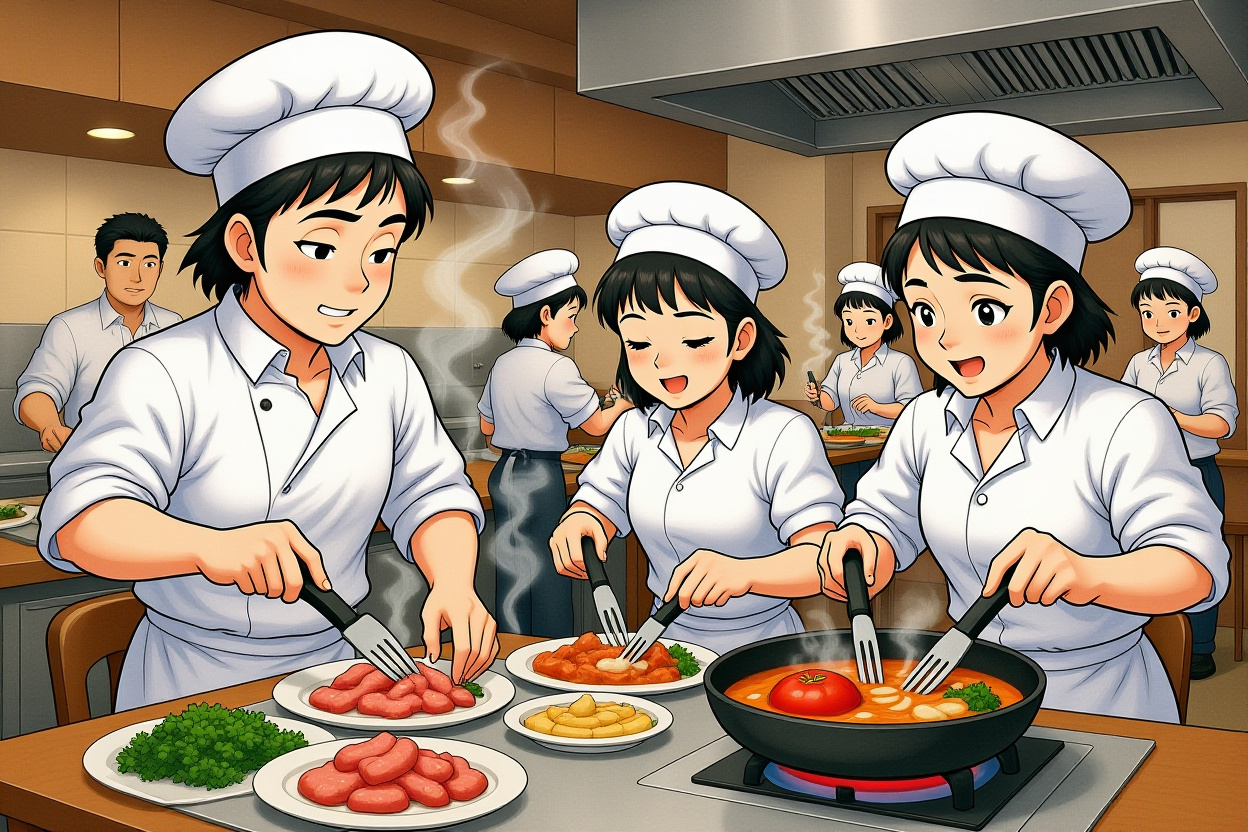The culinary world was set ablaze when prominent entrepreneur Luo Yonghao accused Xi Bei, a well-known Chinese restaurant chain, of serving predominantly pre-made dishes at premium prices. This sparked a fierce debate about transparency, food quality, and customer expectations in modern restaurants. The controversy has raised important questions about what constitutes pre-made food and how restaurants should communicate their preparation methods to customers. Here’s what we discovered from our exclusive interview with a former kitchen employee.
Key Findings:
– Xi Bei denies using industrial pre-made dishes but employs centralized preparation methods
– Most dishes are prepared in the morning and reheated during service hours
– Shopping mall locations cannot use open flames, affecting ‘wok hei’ (breath of the wok)
– Standardized recipes ensure consistency across all locations
– The controversy highlights consumer confusion about food preparation terminology
The Controversy Erupts
On September 10, 2025, technology entrepreneur Luo Yonghao took to Weibo to express his disappointment with Xi Bei’s food quality. He claimed that most dishes appeared to be pre-made despite their high prices, calling the practice ‘disgusting.’ His post quickly went viral, attracting thousands of comments and shares from consumers who shared similar experiences. Luo’s criticism struck a chord with many diners who have grown increasingly concerned about food transparency in restaurant chains.
Luo’s call for legislation requiring restaurants to disclose their use of pre-made dishes gained significant support online. Many consumers feel they have a right to know how their food is prepared, especially when paying premium prices. The debate touches on broader issues of food safety, quality, and value in China’s rapidly growing food service industry.
Xi Bei’s Strong Response
Xi Bei founder Jia Guolong responded aggressively to Luo’s accusations, announcing plans to take legal action against the entrepreneur. Jia claimed Luo’s statements went beyond normal consumer criticism and severely damaged Xi Bei’s reputation. In a bold move, the restaurant chain announced it would open all kitchen areas to public viewing starting September 12, allowing customers to witness food preparation firsthand.
The company also introduced a special ‘Luo Yonghao menu’ featuring dishes mentioned in the controversy, inviting customers to judge their quality themselves. This unprecedented transparency initiative represents a significant shift in how restaurants might address customer concerns in the future. The move has been both praised as innovative and criticized as a publicity stunt.
Inside Xi Bei’s Kitchen Operations
Our exclusive interview with a former Xi Bei kitchen employee reveals detailed insights into the restaurant’s food preparation processes. The employee, who worked for six months in 2024, described a system that relies on morning preparation rather than industrial pre-made dishes. This distinction is crucial to understanding the current controversy.
According to the employee, most dishes are prepared fresh each morning using raw ingredients that are cut, marinated, and partially cooked before service hours. For example, the popular potato stew with beef involves fresh potatoes and beef that are cut and cooked in the morning, then portioned and stored in refrigeration until ordered. During peak hours, these pre-prepared components are finished cooking or reheated before serving.
The Preparation Timeline
The kitchen staff typically arrives around 8:30 AM to begin preparation work. On weekdays, the preparation takes approximately two hours, while weekends require about three hours of advance cooking due to higher customer volume. This system allows the restaurant to maintain efficiency during busy service periods while using fresh ingredients.
The employee emphasized that all meat and vegetables are fresh and cut daily rather than using pre-cut or frozen ingredients. However, some dishes like certain soups and sauces use standardized seasoning packets that kitchen staff prepare according to strict measurements. These are not industrial pre-made sauce packets but rather pre-measured combinations of spices and seasonings that ensure consistency across all locations.
Defining Pre-Made Dishes
The heart of the controversy lies in the definition of ‘pre-made dishes.’ From the kitchen employee’s perspective, food prepared fresh in the morning and served the same day doesn’t qualify as pre-made in the industrial sense. However, many consumers consider any dish not cooked to order as pre-made, regardless of when it was prepared.
Industrial pre-made dishes typically involve food prepared in central factories, frozen, and shipped to restaurants where they’re simply reheated. These products often contain preservatives and have longer shelf lives. Xi Bei’s approach involves same-day preparation using fresh ingredients without freezing, which the company argues represents a different category of food preparation.
Consumer Perception vs. Kitchen Reality
Several factors contribute to why customers might perceive Xi Bei’s food as pre-made despite the company’s claims. The most significant factor is the absence of ‘wok hei’ or the distinctive flavor and aroma that comes from high-heat stir-frying. As the employee explained, shopping mall locations cannot use open flames due to safety regulations, resulting in food that lacks this characteristic restaurant quality.
Additionally, the inability to customize certain dishes leads some customers to suspect pre-made components. Dishes like stir-fried beef with chili cannot be made without chili because the chili is integral to the cooking process from the beginning. Similarly, potato stew without potatoes would require completely altering the dish’s preparation method.
Standardization across locations also contributes to this perception. When every portion of potato stew tastes identical nationwide, customers naturally suspect centralized preparation rather than individual chefs’ craftsmanship. However, this consistency results from precise measurements and standardized recipes rather than industrial pre-made components.
The Central Kitchen’s Role
Xi Bei operates a central kitchen system that supplies certain components to all locations. According to the former employee, the central kitchen primarily handles meat portioning and some sauce preparations. Each restaurant receives measured portions of meat and pre-measured seasoning packets that kitchen staff combine with fresh ingredients prepared on-site.
This system ensures consistency while maintaining quality control. For example, the lamb used for grilled skewers arrives pre-portioned but requires marinating and cooking at each location. The central kitchen also supplies spice packets for dishes like lamb soup, which kitchen staff combine with fresh bones and meat for boiling.
Specific Dish Preparation Methods
Different dishes receive different treatment in Xi Bei’s kitchens. Grilled items like skewers and fish are cooked to order using pre-marinated ingredients. Stir-fried dishes involve pre-cut ingredients that are cooked when ordered. Stews and braised dishes are prepared in large batches in the morning and reheated during service.
The employee provided specific examples: ‘Grilled lamb skewers are marinated in the morning and grilled when ordered. Potato stew with beef is cooked in the morning and reheated when ordered. Stir-fried dishes like sautéed prairie beef involve pre-cut ingredients that are cooked quickly when ordered.’
Cold dishes and some appetizers may involve more advance preparation, but according to the employee, these still use fresh ingredients prepared daily rather than pre-packaged components. The exception might be certain specialty items that require particular preparation methods unavailable at individual locations.
Industry Perspectives on Food Preparation
The Xi Bei controversy reflects broader industry trends toward kitchen efficiency and consistency. As restaurant chains expand, they face increasing pressure to maintain identical quality across hundreds of locations while controlling costs. This often leads to centralized preparation systems that critics argue compromise food quality and authenticity.
Many successful restaurant chains worldwide use similar preparation methods without facing equivalent criticism. The difference often lies in customer expectations and transparency. International chains like Cheesecake Factory or Maggiano’s openly discuss their kitchen systems without facing backlash because customers understand what they’re paying for.
The Future of Restaurant Transparency
The Xi Bei controversy may accelerate moves toward greater transparency in China’s food service industry. Consumers increasingly want to know how their food is prepared, where ingredients originate, and what processes ensure safety and quality. Restaurants that embrace this transparency may gain competitive advantages despite higher operational costs.
Some industry experts predict that open kitchens and live cooking demonstrations will become more common as restaurants seek to differentiate themselves from competitors using industrial preparation methods. The success of Xi Bei’s kitchen openness initiative may determine whether other chains follow similar transparency measures.
Legal and Regulatory Implications
Luo Yonghao’s call for legislation requiring pre-made dish disclosure has gained traction among consumers and policymakers. Several food safety experts have endorsed the idea, arguing that consumers have a right to know how their food is prepared. However, restaurant industry associations have pushed back, claiming such requirements would create unnecessary burdens without improving food safety.
The key challenge lies in defining what constitutes a ‘pre-made dish’ for regulatory purposes. Should dishes prepared same-day in restaurant kitchens be treated the same as factory-produced frozen meals? How should restaurants communicate preparation methods without misleading customers? These questions remain unanswered but will likely shape future food regulations.
Consumer Education Needs
Part of the controversy stems from consumer misunderstanding of restaurant kitchen operations. Most customers have little knowledge of how commercial kitchens function or what constitutes normal preparation methods. Better consumer education about food preparation might help manage expectations and reduce controversies like the current situation with Xi Bei.
Restaurants could take more initiative in explaining their cooking processes and ingredient sourcing. Transparent communication about why certain dishes cannot be customized or why open flames aren’t used might help customers understand what they’re experiencing rather than jumping to conclusions about pre-made ingredients.
The Path Forward for Restaurants
The Xi Bei controversy offers important lessons for restaurant chains operating in China’s competitive food market. Customer expectations are evolving rapidly, and transparency has become increasingly important. Chains that adapt to these changing expectations while maintaining quality and efficiency will likely thrive, while those resisting transparency may face similar controversies.
Restaurants might consider several strategies moving forward: implementing partial open kitchen concepts, providing detailed information about preparation methods, offering more customization options where feasible, and educating staff to better explain cooking processes to curious customers.
Successful chains will likely embrace hybrid models that combine efficiency with craftsmanship—using centralized preparation for certain components while maintaining live cooking for signature dishes. This approach balances operational needs with customer expectations for freshness and authenticity.
The restaurant industry stands at a crossroads where customer expectations and operational realities increasingly conflict. The Xi Bei controversy highlights the growing gap between how restaurants actually operate and how customers perceive that operation. Bridging this gap requires greater transparency, better communication, and perhaps rethinking some kitchen practices.
As consumers become more knowledgeable about food preparation, restaurants must adapt their practices and communication strategies. Those that embrace transparency and quality will likely succeed, while those resisting change may face increasing criticism. The industry’s future may depend on finding the right balance between efficiency and authenticity.
We encourage readers to share their dining experiences and thoughts on restaurant transparency. Your feedback helps shape the conversation about food quality and authenticity in modern restaurants. Visit reputable food review platforms to learn more about how your favorite restaurants prepare their dishes and make informed dining choices.




